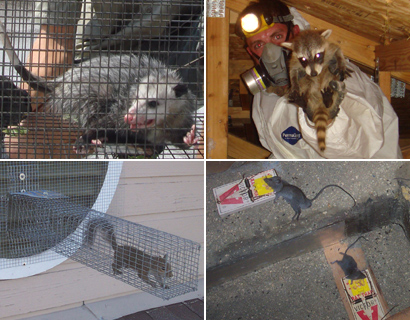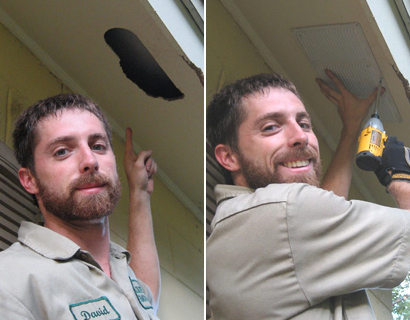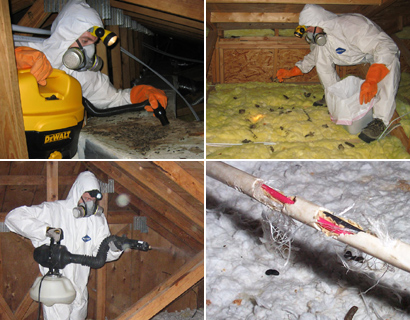- How We Solve Long Island, New York Wildlife Problems
How We Solve Suffolk County Wildlife Problems
INSPECTION: Once on site, we will perform a full inspection of your home and property. This allows us to use the correct strategy and traps. If the animals are in an attic, a full building inspection is crucial, including the following:
- All ground-level areas, such as piper or A/C line entry & exit areas, A/C chase bottoms, ground-level vents, etc.
- All mid-level areas, such as dryer vents, siding gaps, first floor eaves or dormers, etc.
- We inspect the entire roof, including all plumbing stacks, ridge caps, vents, and other potential gaps or holes.
- We also inspect inside your attic, to identify animals and damage they have caused.
- If the animals are outside, we notice many subtle clues that will assist us in a successful strategy.
TRAPPING, EXCLUSION, REMOVAL: Once we understand what animal species we are dealing with, and the problem, we use the most effective means of removing the animals. We use dozens of different types of traps.
- Trapping - If trapping the animal(s) in live cage traps, trap type, set, and location are crucial to success.
- Exclusion - Oftentimes, we are able to simply set one-way doors or other exclusion devices that allow the animals inside a building to safely exit, but never get back inside.
- Removal By Hand - Sometimes we actually remove animals by hand, or with special tools like snare poles.
- The Law - In all cases, we obey state and local laws regarding wildlife, but aim to take the most humane approach.
ENTRY HOLE REPAIRS: Repairs are a crucial step in the wildlife removal process. In many cases, such as bat or rodent control, the job cannot be performed without detailed repairs, and in all cases, sealing the entry holes shut ensures that no future wildlife will ever enter your home.
- 100% of the entry holes must be found, and sealed shut, or the job is not complete.
- Our repairs are professional contractor grade, look good, and when applicable we use steel, which rodents such as rats or squirrels are unable to chew through.
- We give a written guarantee on our repairs against any future animal entry.
ATTIC DECONTAMINATION SERVICES: It may be desirable to clean your attic after we've removed the animals. They can leave behind large amounts of droppings, urine, hair, oils, food, nesting material, and so on. These remnants can attract insects like cockroaches, and the scent left behind can encourage new animals to chew their way into your house. You might experience odor problems from the waste. It's possible that mold will grow on waste areas.
- We remove or vacuum all droppings, or remove all the soiled insulation.
- We fog the attic with a special enzyme-based cleaner that destroys any organic matter and deodorizes the space.
- We repair damage, such as ductwork, electrical wires, pipes, insulation, and more.
Rats and bats are two of the worst wildlife critters to have living in your attic, basement, or walls. They are experts at making their way in undetected. Maybe you've been hearing some movement in the problem areas at night? Maybe you've noticed a bad smell due to one of these critters dying in your home? What ever the case may be, we are happy to provide you with our top of the line wildlife trapping and removal service. We answer our phones 24/7 to help keep your home as well as your family safe. We service the following cities: Amityville, Greenport, Deer Park, Sag Harbor, West Babylon, Shelter Island, Westhampton Beach, Huntington Station, Dix Hills, East Islip, Bayport, Copiague, North Babylon, Bellport, East Northport, Wyandanch, Sagaponack, Quogue, Mastic Beach, Cold Spring Harbor, Islandia, Oakdale, Lake Grove, Shoreham, Centerport, Lloyd Harbor, East Farmingdale, Brightwaters, North Amityville, Nissequogue, Ocean Beach, North Lindenhurst, Wheatley Heights, Babylon, Brookhaven, East Hampton, Huntington, Islip, Riverhead, Shelter Island, Smithtown, Southampton, Southold, Sayville, Ronkonkoma, Patchogue, Bohemia, Hauppage, Brentwood, Northport, and Commack. We service the whole east end of Long Island NY.
Other Suffolk County animal pest control topics:
What Kind of Damage do Squirrels Cause in an Attic
How to Keep Raccoons Away From Your Property
Is it Legal to Trap an Opossum
Should You Trap a Bat in a Cage
To learn more about our services, visit the Suffolk County wildlife control home page.
This month's wildlife how-to article: How to find and remove dead pigeon
How to find and remove dead pigeon
Pigeons often find their ways into places such as roof tops, garages, patios, gardens, and the attic, thus , you must search for a dead pigeon around these places before any other place within your property. To find and remove a dead pigeon, the first step you must take is to try as much as possible to use your sense of smell. Try and sniff through the walls, doors and every region within the house and then go outside and check the garage, patio, and every compartment. There is a high probability that you will be able to detect the dead pigeon based on where the smell is emanating from. . In most cases, the odour of the dead pigeon should vary from mild to strong; depending on how long the pigeon has died. A pigeon that died few hours or less than a day may not produce any odour or may produce a slight stench, however a dead pigeon that has not been removed for 2 days or more will produce a strong offensive odour that will be too strong to bear.
Difficult places such as the attic may require some extra care and protection for your body when removing a dead pigeon. For instance, removing a dead pigeon from the attic may require that you wear protective gloves, a protective body-covering overall and some facial mast so as to protect yourself from inhaling fecal materials or droppings left by a dead pigeon or coming in contact with blood, saliva or any other material that can cause the transmission of diseases from the dead pigeon. The stench from the carcass of the pigeon may be too strong to bear in the attic; this is why you may need to wear a protective mask.
Once the dead pigeon has been removed, you will need to clean the area with some disinfectants to ensure or a sanitizer, to ensure that remaining bacteria and other disease vectors are eliminated. While the use of an animal control company may be recommended, the use of poisonous gases or chemicals in removing dead pigeons from homes may cause more damages to properties than good, therefore, it is more advisable to use mechanical methods of removal. Once removed, the dead pigeon must be disposed in a sealed container and must be burnt immediately or the carcass must be disposed into an incinerator where it can be processed effectively without contaminating the environment.





